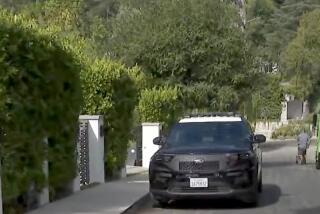Central L.A. Leads City in Violent Crime : Law enforcement: Area accounted for about 64% of incidents last year, including 830 homicides. Residents, officials blame a proliferation of guns and a breakdown in values.
Central Los Angeles accounted for nearly two-thirds of all violent crimes reported citywide in 1992, according to Police Department data. The area’s percentage of homicides, rapes, robberies and assaults remained about the same as 1991.
The data was logged by nine police stations from the Eastside to Koreatown to South-Central that serve the central city. There were no separate figures on the violent crimes that resulted from the spring riots, a department spokesman said.
In 1992, the police stations in the area recorded 830 of the record 1,095 homicides citywide. There were 770 murders in Central Los Angeles the year before. The most crime-ridden sections were South Los Angeles and Pico-Union/Westlake.
“Unfortunately, there’s a lot of people who are willing to resolve their differences with violence,” said Lt. Thomas (Reggie) Maeweather, who grew up near the 77th Street police station in South-Central and now commands the detective unit there.
The division patrols the deadliest zone in Central Los Angeles. In the 77th Street station’s area--roughly 15 square miles and home to about 200,000 people--there were 144 homicides, 176 rapes, 3,448 robberies and 4,164 assaults reported in 1992. The adjacent Southeast police station, which covers about 10 square miles and approximately 150,000 residents, recorded 124 homicides, 146 rapes, 2,686 robberies and 4,426 assaults.
Despite a truce by rival gangs, Maeweather said, gang-related violence accounted for about half of the homicides reported by those two South Los Angeles police stations. He noted that homicide can include vehicular manslaughter.
In the Rampart Division, which covers Pico-Union and Westlake, 138 homicides, 173 rapes, 4,084 robberies and 4,754 assaults were reported. About 275,000 residents live in the eight-square-mile division.
“People here feel like there’s no solution,” said Pico-Union resident Sandra Figueroa, who heads El Centro del Pueblo, a community service organization based in Silver Lake.
Officials, residents, religious leaders and police blame the violence on the proliferation of guns and on a deterioration of values and respect for human life.
“We just have an intolerably high level of violence in our society bordering on a breakdown of common civility,” said City Councilman Mark Ridley-Thomas, whose 8th District includes the 77th Street Division.
He and others also say the violence stems from the despair caused by high unemployment and poverty. In violence-plagued portions of Southeast Los Angeles, for example, the median annual income level was $15,904, compared with $33,167 for Los Angeles County, according to the 1990 Census.
Figueroa and other residents say more police officers would provide some short-term relief. But Cmdr. David Gascon, a Police Department spokesman, said the city’s 7,700 uniformed officers are stretched thin and a plan to redeploy 150 officers from desk jobs to patrol duties would be “a drop in the bucket.”
“We just don’t have the resources,” said Gascon, who added that at least 10,000 officers are needed to protect the city.
The City Council voted this month to place a measure on the April ballot that would increase property taxes about $73 for a 1,500-square-foot home to pay for 1,000 additional officers. A similar proposal was voted down last year.
According to the latest figures available--a 1990 survey by the Washington-based Police Foundation--the Los Angeles Police Department had 8,456 sworn personnel, or about 2.4 officers per 1,000 residents. That same year, New York had 26,550 sworn officers, or 3.6 per 1,000 residents; Chicago had 12,028 sworn personnel, or about 4.3 per 1,000 residents; and Houston had 4,092 sworn personnel, or about 2.5 per 1,000 residents.
The Rev. E.V. Hill, pastor of Mt. Zion Missionary Baptist Church at Hoover and 50th streets, questioned why the city could not move some of its officers to Central Los Angeles from less crime-ridden parts of the city such as the Westside. “This area is not getting the proper protection,” he said.
According to the LAPD, there were about 1,270 officers last year in the department’s South Bureau, which includes South Los Angeles. The four stations in that bureau recorded 381 homicides in 1992. In contrast, about 1,280 officers last year were at the four Westside stations in the department’s West Bureau, which recorded 131 homicides in 1992.
However, the South Bureau has fewer people--587,000 compared with 788,000 in the West Bureau--and covers about half the area, according to department statistics.
Nonetheless, Gascon said the answer is not to beef up the department’s presence in the central city by transferring officers from outlying areas, but to hire more people. “You have crime in all parts of the city,” he said.
Although people interviewed agreed that more police would help in the short-term, they said long-term solutions would not be easy.
Ridley-Thomas said officials, ministers and educators would have to work together on such measures as job creation, educational reform and teaching youths to resolve disputes peacefully. Figueroa said residents would have to take back their neighborhoods block by block. And Hill said city officials should convene a blue-ribbon panel composed of the best and the brightest in the government and private sectors to devise solutions.
“There is no magic wand to wave,” said Hill. “But we have to do something because too many people are dying.”
More to Read
Sign up for Essential California
The most important California stories and recommendations in your inbox every morning.
You may occasionally receive promotional content from the Los Angeles Times.











